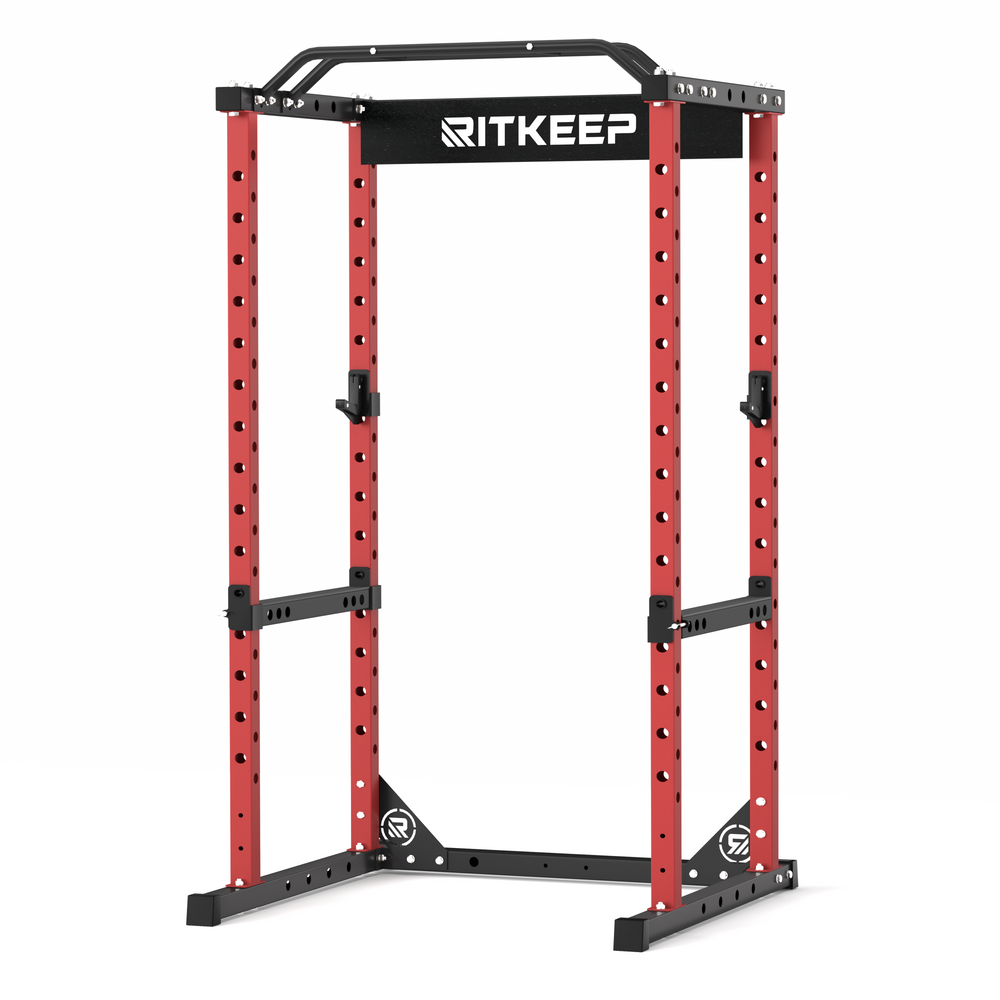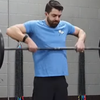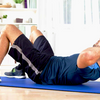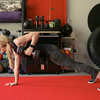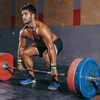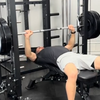6 Best Shoulder Workout Routine To Build Strength: Anatomy, Forms, Mistakes & Tips
The dumbbells serve as effective tools for cultivating robust and aesthetically pleasing shoulder muscles. Opting for dumbbells in shoulder training can notably alleviate strain on your wrist, elbow, and shoulder joints due to the enhanced range of motion they allow. Furthermore, the inclusion of dumbbells grants you access to a diverse array of exercises, varied grips, and an expanded range of motion. Notably, the capacity to address strength imbalances between sides is enhanced by the unilateral lifting of each dumbbell.

Within this article, we're not only delving into the elements and fundamental principles governing shoulder muscle movement, but we're also encompassing the typical arm exercises using dumbbells. Whether you're an entry-level enthusiast or a seasoned fitness expert, these exercises hold indispensable significance within your daily training regimen:
- What Are Shoulder Muscles
- How Do Shoulder Muscles Move
- Benefit Of Training The Shoulders
- 6 Best Dumbbell Exercises For Shoulders
- Tips To Warm Up The Shoulders Before Working Out
- Shoulder Workout Plan For Muscle Gains
What Are Shoulder Muscles
The shoulder, a remarkable ball-and-socket joint, facilitates a vast array of movements, from ball-throwing to reaching for objects on high shelves. Termed the glenohumeral joint, it boasts the broadest range of motion of any joint within your body. The support for this joint comes from around eight distinct shoulder muscles, contributing strength, stability, and form.
The primary muscle group that supports the shoulder joint is the Rotator Cuff Muscles and Deltoids. The deltoid muscles are externally visible on the body's surface, while the rotator cuff group is situated deep within the shoulder joint. This group offers crucial structural reinforcement and enables the shoulder to execute a diverse range of movements and functions.
The deltoid muscles consists of 3 parts/heads, whcih plays a crucial role by imparting breadth to the upper body. They are instrumental in achieving the coveted "V-taper physique," a sought-after look characterized by a narrower waist appearance and broader shoulders, which many aspire to attain.

The four Rotator Cuff Muscles include the supraspinatus, infraspinatus, teres minor, and subscapularis, whcih contract and prevent the sliding of the head of the humerus, allowing full range of motion and providing stability.

How Do Shoulder Muscles Move
In the realm of arm movements, there are several key actions that define the range of motion:
- Flexion: transitioning your arm from the side of your body, extending all the way forward and over your head. This motion typically up to 180 degrees.
- Extension: moving your arm behind your back, typically at an angle of 45 to 60 degrees.
- Abduction: elevating your arms from your sides and outwards, eventually reaching a position where your arms are parallel to the floor. This range typically extends up to 90 degrees.
- Adduction: involving the movement of your arms from a position parallel to the floor back to your sides. This movement also generally spans up to 90 degrees.
- Medial or internal rotation: keeping your arm at your side, bending the elbow forward by 90 degrees, and then directing your lower arm towards your body's center.
- Lateral or external rotation: holding arm at your side, elbow bent forward 90 degrees—but the lower arm is moved away from your body's center.
Bearing Olympic Powerlifting Barbell |
All In One Adjustable Dumbbells |
Olympic Low Bounce Rubber Weight Plates |
 |
Benefit Of Training The Shoulders
Benefit #1: Enhanced posture benefits
Cultivating robust shoulders and triceps can contribute significantly to refining your posture and mitigating the chances of injury and discomfort stemming from inadequate alignment. Engaging in shoulder extension exercises effectively targets the upper back muscles. These muscles serve as pivotal pillars in bolstering the spine's stability and upholding optimal posture.
Benefit #2: Enhanced shoulder mobility
Engaging in shoulder extension exercises contributes to heightened shoulder mobility, thereby diminishing the likelihood of injuries. Moreover, this improved mobility translates to better execution in various exercises demanding shoulder flexibility.
Benefit #3: Enhanced triceps strength
Crucial for upper body function, the triceps play a vital role in extending the arms and providing stability to the shoulders during pushing actions. Engaging in shoulder extension exercises efficiently zeroes in on the triceps, fostering strength development and subsequently enhancing overall performance across various workout routines.
6 Best Dumbbell Exercises For Shoulders
1. Dumbbell Shoulder Press
The dumbbell shoulder press ranks among the top exercises for enhancing both shoulder size and strength. By engaging multiple muscle groups simultaneously, it enables lifting substantial weights. Its main focus lies on the front deltoids and triceps. Executing the dumbbell shoulder press can be approached from either a seated or standing position. Opting for the seated variation proves superior for fostering shoulder mass, as it isolates the shoulders while eliminating leg and lower back support.

How To Do The Dumbell Shoulders Press
- Select an appropriate weight for your desired rep count. Lift each dumbbell, positioning them on your shoulders or just slightly above, while your palms face forward.
- Elevate the weights overhead, bringing the dumbbells together above your head. Subsequently, lower the weights until they rest once more on your shoulders.
- Execute complete repetitions, ensuring a full range of motion—ascending and descending entirely. Expanding the range of motion engages more muscle fibers, promoting enhanced shoulder muscle development.
- Repeat these instructions for your designated set and rep quantity, aiming to maintain a consistent weight throughout your workout.
Common Mistakes On Dumbbell Shoulder Press Form
Mistake #1: Pressing one arm higher than the other
Due to the natural strength imbalance between the sides of our body, it's common to encounter difficulty in fully extending the weaker arm (for instance, the left arm for right-handed individuals).To fix this issue, Opt for dumbbells of a manageable weight that enables you to perform complete repetitions using your less dominant side. While these dumbbells might seem less challenging for your stronger side, this approach gradually allows your weaker side to bridge the gap and attain parity in arm extension.
Mistake #2: Slamming the dumbbells together
During the overhead press with dumbbells, your hands tend to come closer together as a natural movement. It's important to note that some individuals overemphasize this motion by forcefully bringing the dumbbells together at the peak of each repetition. This action not only disrupts your equilibrium but also adds complexity to controlling the exercise. To handle this, Envision the concept of "propelling the dumbbells towards the ceiling." By adopting this mental cue, you not only enhance your lifting capacity but also direct your attention towards a vertical pressing motion. This approach prevents the dumbbells from colliding with each other and ensures a smoother execution.
Mistake #3: Incomplete range of motion
As you advance to lifting heavier weights, the temptation to take shortcuts might arise, leading to a reduction in the range of motion. This often translates to only partially lowering the dumbbells, stopping around eye level. Which may ultimately diminish the effectiveness of the exercise. The primary reason is attempting to lift weights beyond your capability. The remedy lies in opting for weights that permit you to complete full repetitions before advancing further. It's crucial to allocate ample time for your body to undergo growth and fortification.
2. Dumbbell Arnold Press
The dumbbell Arnold press, named in honor of the legendary Arnold Schwarzenegger, is a dynamic exercise known for its rotational movement and expansive range of motion. This unique exercise effectively increases the time your deltoid muscles spend under tension, engaging all three deltoid heads. By pressing weights in multiple planes of motion, it targets a broader range of deltoid muscle fibers. When executed with higher repetitions, it delivers an intense and satisfying shoulder workout.
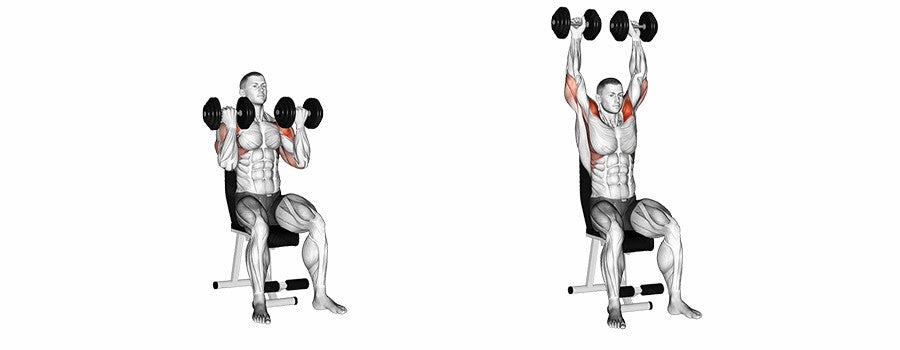
How To Do The Dumbell Arnold Press
- Begin by sitting upright on an incline bench with your back well-supported.
- Hold a dumbbell in each hand at shoulder height with your palms facing your shoulders.
- In a fluid motion, push the dumbbells upward while simultaneously rotating your palms to face forward.
- Continue to lift the dumbbells until your biceps are in line with or slightly behind your ears.
- Pause briefly at the top of the movement to engage your shoulder muscles.
- Slowly reverse the motion by lowering the dumbbells back to the starting position with control.
Common Mistakes On umbell Arnold Press
Mistake #1: Exploit momentum
One frequent mistake involves relying on momentum to execute the exercise rather than actively involving your muscles. You can easily spot this error if you observe your upper body and arms moving erratically, resembling the flailing of an inflatable tube man.
Mistake #2: Forgetting your core
Another overlooked yet vital aspect of this exercise is none other than engaging your core muscles. To stabilize your upper body effectively and facilitate the proper rotation and twisting of your shoulders, it's imperative to actively involve your abdominal muscles.
3. Dumbbell Front Raise
The dumbbell front raise stands out as a top-notch choice for fostering shoulder muscle growth. This isolation exercise zeroes in on the anterior aspect of the shoulder. Given the nature of isolation exercises, opting for lighter weights becomes essential due to the intensified focus on a specific body segment.
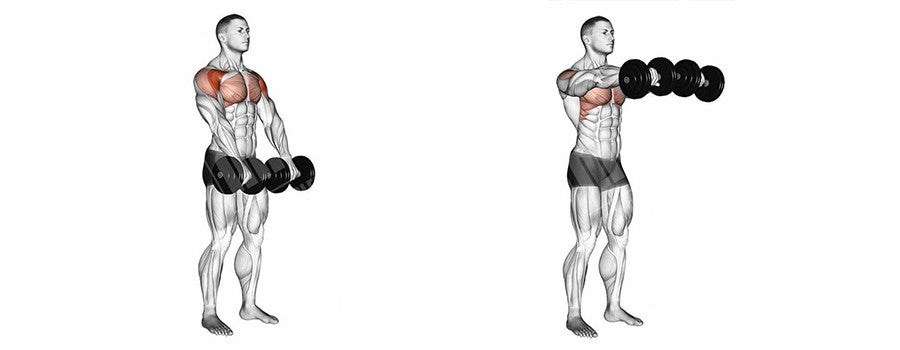
How To Do The Dumbell Shoulders Front Raise
- Maintain an upright stance as you grasp a pair of dumbbells against your thighs, ensuring your palms are oriented inward.
- Elevate one dumbbell at a time, directing it to slightly surpass your shoulder level. Keep your arm mostly extended yet with a relaxed elbow, and have your palms oriented downward. Simultaneously, let your other arm rest against your thigh.
- Pause briefly at the zenith for approximately one second before gradually lowering the dumbbell. Subsequently, raise the opposite arm and replicate the sequence.
Common Mistakes On Dumbbell Shoulder Front Raise
Mistake #1: Swinging your weights
The key here is deliberate pacing. The dumbbell front raise demands a deliberate and controlled approach. Do not allow your ego to overshadow your muscle engagement, emphasizing the importance of maintaining proper form and pace. Start your movement prep with lighter weights until you feel really comfortable that you have the exercise down pat. Then, you can feel free to increase the load with your next sets.
Mistake #2: Shrugging your shoulders
Frequently, individuals unconsciously shrug their shoulders, unaware of this action. The incorrect approach involves initiating the movement by elevating the shoulders in a shrugging manner is not advisable. Tension tends to accumulate in the trapezius muscles, leading to an upward shoulder shrug, instead of engaging the deltoids as intended. To avoid this common mistake, try to pull your shoulder blades down into your back pockets the entire time you lift and lower the weights.
Mistake #3: Bending the elbows too much
During this movement, it's entirely natural and advisable to maintain a slight bend in the elbows. However, excessively bending them can lead to redistributing the load across different areas of the arm, which might result in discomfort. In cases where the weight is overly challenging, causing an excessive elbow bend, opt for a lighter weight to ensure a more optimal and effective movement pattern.
4. Dumbbell Side Lateral Raise
The dumbbell side lateral raise effectively targets the lateral head of the shoulders, which greatly influences the overall shoulder appearance. To enhance the size of this muscle, prioritizing shoulder abduction—moving the arm outward from the body—is key. Optimal results can be achieved with moderate to light weights, focusing on higher repetitions. This shoulder workout can be executed while seated or standing. Opting for a seated position offers the advantage of minimizing lower back support, thereby intensifying the workload on the shoulders.

How To Do The Dumbell Side Lateral Raise
- Hold a dumbbell in each hand and take a seat on a bench with your palms facing inward, positioned alongside your thighs.
- Raise your arms out to the sides, ensuring your knuckles align with your shoulders, and maintain this pose briefly before slowly returning the weights to the initial position.
- Concentrate on targeting your shoulder muscles, as this will help prevent your trapezius muscles from assisting too much.
- For the standing variation of this exercise, assume the same posture as you would for front raises but with your arms at your sides.
- Aim to complete 2 to 3 sets of 12 to 15 repetitions.
Common Mistakes On Dumbbell Side Lateral Raise
Mistake #1: Swing your arms
Avoid swinging your arms when lifting weights, as relying on momentum won't yield the desired results. Instead, concentrate on executing slow, deliberate movements while maintaining core engagement for effective and controlled strength training.
Mistake #2: Holding your arms and body too straight
Another common mistake observed during lateral raises is maintaining overly straight arms, which can hinder proper form. It's essential to avoid locking your arms into a completely straight line. Instead, aim for a slight flexion at the elbows, ideally falling within the range of 20 to 30 degrees. When lifting the weights, ensure a controlled motion that takes them up to shoulder height. Avoid any swinging or jerking movements to hoist the weights.
Mistake #3: Using a tempo that’s too fast
To maximize the benefits of lateral raises with lighter weights, it's essential to focus on controlling the tempo of the exercise. Slowing down the pace and performing the movement in a deliberate and controlled manner is key. This controlled tempo increases the time your muscles spend under tension, which is crucial for muscle engagement and growth. Pay special attention to maintaining a slow and controlled motion as you lower your arms back to the starting position. This deliberate movement engages a greater number of muscle fibers to assist in lowering the weight smoothly.
5. Dumbbell Bent-over Raise
The dumbbell bent-over raise targets the rear deltoid muscles, which are located at the back of the shoulder. Often, these muscles are less developed compared to other shoulder muscles. However, if your goal is to achieve well-defined shoulders with increased muscle mass, it's crucial not to neglect the posterior deltoids. This exercise can be performed either in a seated or standing position. Similar to front and side raises, the dumbbell bent-over raise can be executed with lighter weights and higher repetitions. Focus on proper form and gradually increase the weight as you become more comfortable and experienced with the exercise.

How To Do The Dumbbell Bent-over Raise
- Keep a straight spine, leaning forward until your torso is nearly parallel to the ground. Maintain a neutral head position without tilting it upwards.
- Hold dumbbells in front of you with palms facing each other, keeping your elbows slightly bent but not locked. Initiate the movement by engaging your rear deltoid muscles and lifting your elbows towards the ceiling, executing a reverse fly motion. The dumbbells should reach a position close to parallel with the floor, with your palms facing downwards.
- Throughout the exercise, keep your core engaged to stabilize your torso, and ensure minimal movement in your core region. Aim to complete 2 to 3 sets of 12 to 15 repetitions for an effective workout.
Common Mistakes On Dumbbell Bent-over Raise
Mistake #1: Using too much weight
The rear deltoid muscle, located in the back, is relatively small and less powerful compared to nearby muscles. Therefore, it's advisable to use lighter weights when targeting this specific muscle group. The reason behind this recommendation is that the surrounding muscles in the back are considerably stronger. Using heavier weights can lead to improper form and technique, as even a slight increase in load beyond the optimal range can cause the dominant engagement of other, more powerful muscles, detracting from the intended isolation of the rear deltoid.
Mistake #2: Utilizing the hips to create force or movement
One of the most common forms of cheating when performing bent-over movements is to use the hips to generate momentum to help propel the weight through space, which does nothing more than decrease the demand on the desired muscle groups.
6. Dumbbell Upright Row
The dumbbell upright row is a versatile exercise that can be adjusted to target either your shoulders or traps, depending on your elbow positioning. If you maintain a narrow elbow stance, the exercise primarily engages your traps. Conversely, a wider elbow positioning places more emphasis on the side deltoid muscles. This exercise is considered compound, which means it involves multiple muscle groups, allowing you to lift heavier weights for increased strength and muscle development.

How To Do The Dumbbell Upright Row
- Begin by picking up a pair of dumbbells and stand upright. Allow the dumbbells to hang in front of your thighs, with your palms facing downward.
- Activate your shoulder muscles, specifically the ones on the sides, and raise your hands and elbows upward while keeping your palms facing the floor.
- At the peak of the motion, when your muscles are fully contracted, ensure that the dumbbells in your hands align with your shoulders and face forward. There should be an approximate 90-degree bend from your elbow to your shoulder.
- Maintain this position for a second, then slowly return to the starting position.
- Aim to complete 3 sets of 8 to 12 repetitions for an effective workout routine.
Common Mistakes On Dumbbell Upright Row
Mistake #1: Elbows are too high
Lifting your arms beyond shoulder level can potentially lead to shoulder injuries. It's essential to cease the movement when your elbows reach shoulder height to minimize the risk of injury.
Mistake #2: Lift too much weight
If the weight you select is excessively heavy, it can force you to use momentum during the exercise, diverting attention away from your shoulders, or, more detrimentally, subjecting your shoulders to excessive strain. Opt for a suitable weight that enables a deliberate, controlled, and gradual movement to ensure optimal form and safety.
RitKeep Cable Machine 5pcs Lat Pull Down Bar Combo |
RitKeep RAB-3000 Adjustable Heavy Duty Inlcine Weight Bench |
All In One Adjustable Weight Dumbbells |
 |
Tips To Warm Up The Shoulders Before Working Out
The shoulder is a complex structure heavily reliant on surrounding muscles and tendons for stability. This dynamic stability enables a wide range of motion but also increases susceptibility to injuries like dislocations, strains, and impingements.
Warm-up exercises play a vital role in enhancing the shoulder joint's resilience to the physical demands of exercise. They achieve this by elevating the temperature and flexibility of the adjacent muscles and tendons. This warm-up routine is especially crucial for injury prevention in activities like heavy weightlifting and any sport that places strain on this delicate joint.
Tip #1: Start by doing arm cricles
Before diving into a shoulder workout, it's crucial to ensure adequate blood flow to the joints, especially to safeguard against common injuries like rotator cuff issues. To accomplish this, incorporate arm circles into your routine. Begin by standing with your feet hip-width apart and extending both arms straight out to your sides, forming a "T" shape. Initiate small, controlled circles with your arms, rotating them clockwise and counterclockwise for approximately 10-15 seconds each. Repeat this sequence 3-4 times. You might feel a gentle burn, which is normal, but there should be no pain.
Tip #2: Band over and backs
In addition to promoting blood circulation, this exercise also fosters proper stability in the joints by engaging both the smaller muscles, such as the rotator cuff and the larger shoulder muscles. To begin, stand with your feet positioned shoulder-width apart and your arms hanging down at your sides, slightly wider than shoulder width. Hold a flexible band in your hands with your palms facing downward. Create tension in the band by pulling it apart as you raise it up and over your head, then guide it down behind your hips. Throughout this movement, keep your elbows fully extended.
Tip #3: Internal and external rotation exercise between sets
The internal rotation exercise focuses on the subscapularis muscle, a crucial component of the rotator cuff. The rotator cuff muscles play a vital role in stabilizing the shoulder joint. Specifically, the subscapularis muscle is responsible for inwardly rotating the humerus, or the long bone of the arm, toward the body. This exercise is instrumental in maintaining shoulder strength and stability.
Tip #4: Dynamic hug
The subscapularis muscle is often overlooked but can be prone to injury. To address this issue, start by positioning the band or pulley below chest level. Stand with your back to the fulcrum and grasp both ends of the band with your hands. Initiate a controlled movement that mimics a hugging or tackling motion. Concentrate on feeling the contraction occurring within the shoulder blades rather than in the chest. This exercise can help target and strengthen the subscapularis muscle, potentially preventing injuries and improving shoulder health.
Tip #5: Face pulls
Face pulls are a highly effective shoulder warm-up exercise that can be performed using either resistance bands or a cable machine. They serve to engage and activate the entire shoulder muscle group while also strengthening the core and posterior deltoids, which makes them an excellent choice for preparing your shoulders before workouts that involve movements like deadlifts and overhead presses.
Shoulder Workout Plan For Muscle Gains
This workout contains multiple dumbbell shoulder exercises that are designed to target all the muscles in your shoulder and increase overall muscle mass.
| Exercises | Set and Reps |
| Dumbbell Shoulder Press | 3 sets x 10-12 reps |
| Dumbbell Side Lateral Raise | 3 sets x 10-15 reps |
| Bent Over Rear Delt Raises | 3 sets x 15 reps |
| Wide Grip Dumbbell Upright Row | 2 sets x 12-15 reps |
RitKeep Home Gym Equipments | Smith Machine For Sales | PMAX-4550 Multi Functional Smith Machine | PMAX-5600 Smith Machine With Dual Weight Stack
Best Home Gym Gear in RitKeep
These are our most popular home gym machines — combining Smith Machine and Power Rack in one. Perfect for both guided and free weight training to support your everyday fitness goals.
PMAX 5600 All-In-One Smith Machine - Integrated Weight System
✔️ 6 IN 1 Gym Station
✔️ With 320 LB Weight Stack On Each Side
✔️ Feel the Burn Through 80+ Exercises
PMAX 4750 Dual Plate Loaded Multi Functional Smith Machine
✔️ Fuel Your Workout with 100+ Exercises
✔️ Dual Independent Pulley System
✔️ Removable Jammer Arms & Leg Extension
Destroyer M10 ALL-IN-ONE Home Gym Power Rack With Pulley System
✔️ Crossover Cable Pulley System
✔️ Heavy-Duty Multi-Functional Rack
✔️ Offering over 80+ exercises
-
Posted in
Shoulder Workout






